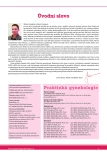The methods of skeletal age assessment
Authors:
D. Zemková
Authors‘ workplace:
Dětská klinika, 2. LF UK a FN v Motole, Praha
Published in:
Prakt Gyn 2011; 15(1): 28-32
Category:
Review Article
Overview
This review article is concerned with the issues of measurement of biological and bone age, interferences between sexual and bone maturation and their clinical implications. There are two basic methods of measurement. The first group of methods is based on inspection by bone atlas – patient’s radiogram is compared to a typical picture for the specific age and sex. Scoring methods are considered to be more accurate; respective bones are evaluated separately, assigned a numerical index and the sum of indexes describes bone maturation. We prefer the third modification (TW3) of Tanner and Whitehouse method that includes current updated European standards. At the beginning of puberty, the correlation between sexual and bone maturation is weak but, with maturation, these processes become synchronised, especially under the influence of estrogens.
Key words:
bone age – biological age – estrogens – puberty
Sources
1. Cameron N. Assessment of maturation: bone age and pubertal assessment. In: Glorieux F, Pettifor JM, Juppner H (eds). Pediatric bone: biology and diseases. London: Academic Press 2003 : 325–338.
2. Tanner JM, Whitehouse RH, Cameron N et al. Assessment of skeletal maturity and prediction of adult height (TW2 Method). 2nd ed. London, San Dieago: Academic Press 1983.
3. Šmahel Z. Principy, teorie a metody auxologie. Učební texty Univerzity Karlovy v Praze. Praha: Karolinum 2001.
4. Brauer BM. Die Bestimmung des biologischen Alters in der sport - und jugendärztlichen Praxis mit einer neuen anthropometrischen Methode. Arztl Jugend 1982; 73(2): 94–100.
5. Marshall WA, Tanner JM. Variations in the pattern of pubertal changes in girls. Arch Dis Child 1969; 44(235): 291–303.
6. Marshall WA, Tanner JM. Variations in the pattern of pubertal changes in boys. Arch Dis Child 1970; 45(239): 13–23.
7. Marshall WA, Tanner JM et al. Puberty. In: Falkner F, Tanner JM (eds). Human Growth: a Comprehensive Treatise. 2nd ed. London: Plenum Press 1986 : 171–209.
8. Šnajderová M, Zemková D. Předčasná puberta. Praha: Galén 2000.
9. Zachmann M, Prader A, Kind HP et al. Testicular volume during adolescence. Cross-sectional and longitudinal studies. Helv Pediatr Acta 1974; 29(1): 61–72.
10. Poland JG. Skiagraphic atlas showing the development of the bones of the wrist and hand. London: Elder 1898.
11. Todd TW. Atlas of skeletal maturation. St. Louis: Mosby 1937.
12. Greulich WW, Pyle SI. Radiographic atlas of skeletal development of the hand and wrist. 2nd ed. Stanford: Stanford University Press 1959.
13. Roch AF, Wainer H, Thissen D. Skeletal Maturity: the knee joint as a biological indicator. London: Plenum 1975.
14. Kapalín V. Osseous age – its evaluation in Czech children of pre-school and school age. Česk Hyg 1967; 12 : 233–245.
15. Kapalín V. Evaluation of the level of development in children and adolescents. Praha: Sborník vědeckých prací Ústavu hygieny 1970 : 7–82.
16. Gilsanz V, Ratib O. Hand bone age. Berlin: Springer 2005.
17. Acheson RM. A method assessing skeletal maturity from radiographs: a report from the Oxford child health survey. J Anat 1954; 88(4): 498–508.
18. Tanner JM, Whitehouse RH, Healz MJ. A new system of estimating the maturite of the hand and wrist with standards derived from 2 600 healthy British children. Part II. The scoring system. Paris: International Childrens Centre 1962.
19. Tanner JM, Healy MJ, Goldstein H et al. Assessment of skeletal maturity and prediction of adult height (TW3 method). London: WB Saunders 2001.
20. Roche AF, Chumlea WC, Thissen D. Assessing of the skeletal maturity of the hand-wrist: FELS method. Springfield: Thomas 1988.
21. Sempé P, Sempé M, Pédron G. Croissance et maturation osseuse: analyse auxologique et radiologique. Paris: ThéraPlix 1972.
22. Krásničanová H, Kovaříková I, Hořák J et al. Bone age assessment – TW3 or GP method? Horm Res 2004; 62 (Suppl 2): S150.
23. Lebl J, Krásničanová H. Růst dětí a jeho poruchy. Praha: Galén 1996.
24. Weise M, De-Levi S, Barnes KM et al. Effects of estrogen on growth plate senescence and epiphyseal fusion. Proc Natl Acad Sci USA 2001; 98(12): 6871–6876.
25. Prader A, Largo RH, Molinari L et al. Physical growth of Swiss children from birth to twenty years of age. First Zurich longitudinal study of growth and development. Helv Paediatr Acta Suppl 1989; 52 : 1–125.
26. Gasser T, Kneip A, Binding A et al. The dynamics of linear growth in distance, velocity and acceleration. Ann Hum Biol 1991; 18(3): 187–205.
27. Bláha P, Krejčovský L. Somatický vývoj českých dětí. Semilongitudinální studie. Praha: PřFUK a SZÚ 2006.
28. Taranger J, Lichtenstein H, Svennberg-Redegren I. The somatic development of children in a swedish urban community: VI. Somatic pubertal development. Acta Pediatr Scand 1976; 258 (Suppl): 121–135.
29. Frank GR. Role of estrogen and androgen in pubertal skeletal physiology. Med Pediatr Oncol 2003; 41(3): 217–221.
Labels
Paediatric gynaecology Gynaecology and obstetrics Reproduction medicineArticle was published in
Practical Gynecology

2011 Issue 1
Most read in this issue
- Necrotic myoma in pregnancy
- The methods of skeletal age assessment
- Cryopreservation of cells and tissues in assisted reproduction
- Correlation between ultrasound, hysteroscopy and histological picture of endometrial polyps
